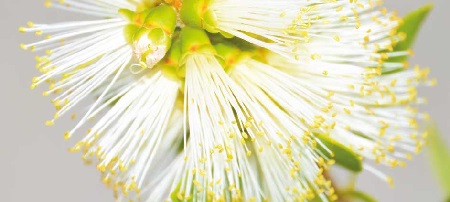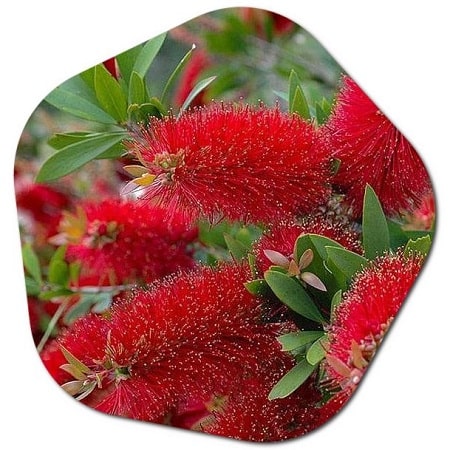What is the use of Callistemon citrinus?
It grows naturally in Australia. 3-5 m tall, densely branched shrub. The evergreen, lance-shaped leaves are 5-7 cm long, 1-1.5 cm wide, very finely hairy and copper-colored when fresh. The vividly colored, 15 cm long flower bracts are formed in dense spikes or rounded racemes, usually by long rope-like stamens. This is why it is called brush bush, as it resembles a brush. After flowering, woody capsules are formed. These capsules remain on the plant for years. It grows well in sunny places. It has good drought tolerance. But it grows best in well-drained soils.

It generally tolerates salty alkaline soils. But sometimes yellowing of the leaves is seen. It is the most common brush bush species in the market. It grows fast, easy to prune. It can be used as informal espaliers to cover the walls in a short time. Callistemon citrinus can also be trained and grown as short trees. It can be used as sheared hedges, informal screens or windbreaks.
What are the benefits of callistemon?
Callistemon Viminalis; This species is an evergreen shrub and tree. It has eye-catching flowers. They do not like cold places. They grow very quickly. The 4-5 cm. long narrow leaves are copper-colored at first and then become bright green. It requires well-drained and moist soil. Brown-red flowers bloom in spring and summer and can stay on the tree all year round. It requires frequent watering and is not wind resistant. Callistemon viminalis, commonly known as bottlebrush, is a genus of evergreen shrubs and small trees that is native to Australia. These plants are valued for various benefits and uses in gardening, landscaping, and even for some practical purposes. Here are some of the benefits of Callistemon:

- Ornamental Value: Callistemon is known for its striking, bottlebrush-like flower spikes, which come in a range of vibrant colors, including red, pink, and yellow. These flowers add a burst of color to gardens and landscapes, making them attractive ornamental plants.
- Wildlife Attraction: The nectar-rich flowers of Callistemon are highly attractive to pollinators, especially bees and butterflies. The plant’s nectar-rich blooms also make it an excellent choice for gardens designed to attract beneficial insects and support pollination.
- Bird Habitat: Callistemon flowers produce copious amounts of nectar, which can attract nectar-feeding birds such as honeyeaters. These birds can contribute to ecological diversity and help with pollination.
- Low Maintenance: Callistemon plants are generally low-maintenance once established. They are drought-tolerant and can thrive in a variety of soil types. Pruning can help maintain their shape and size.
- Screening and Hedging: Callistemon can be used effectively as a hedge or screening plant due to their dense growth habit. This can provide privacy and act as a windbreak in gardens or landscapes.
- Soil Erosion Control: The dense root systems of Callistemon can help stabilize soil on slopes or areas prone to erosion.
- Cut Flowers: The unique bottlebrush flowers make excellent cut flowers for floral arrangements, adding a touch of Australian charm to indoor displays.
- Essential Oil Production: Some Callistemon species, such as Callistemon citrinus, are used for the production of essential oils, often referred to as “lemon-scented tea tree oil.” This oil has various potential uses, including as an antiseptic, insect repellent, and for aromatherapy.
- Fire Resistance: Some Callistemon species have demonstrated fire-resistant qualities, which can be beneficial in fire-prone regions for landscaping in a fire-resistant garden or as a firebreak plant.
It’s important to note that the specific benefits of Callistemon may vary depending on the species and the local growing conditions. Some species are better suited to specific purposes, so it’s advisable to choose the right Callistemon variety for your intended use or benefits in your garden or landscape. Additionally, always be aware of the invasive potential of some species in non-native regions.
What is Callistemon citrinus in English
Callistemon citrinus is commonly known as the “Crimson Bottlebrush.” It is a species of flowering plant in the Myrtaceae family and is native to eastern Australia. The name “Crimson Bottlebrush” is derived from its distinctive, cylindrical, bottlebrush-like flower spikes, which are typically bright red or crimson in color. This plant is widely cultivated for its ornamental value and is also known for attracting nectar-feeding birds due to its vibrant flowers.
When does Callistemon citrinus bloom
Callistemon citrinus, commonly known as the Crimson Bottlebrush, typically blooms in late spring to early summer, which is around the months of May to July in many regions, depending on the local climate. The exact timing of the bloom can vary somewhat based on factors such as temperature, daylight hours, and local growing conditions.
The plant produces distinctive bottlebrush-shaped flower spikes that are usually bright red but can also be found in shades of pink or even white in some cultivated varieties. These flowers are known for their ornamental beauty and attract pollinators like bees and butterflies with their nectar-rich blossoms.
The flowering period of Callistemon citrinus can be influenced by factors such as the age and health of the plant, the specific variety or cultivar, and local climate variations. It’s important to note that while this is the typical bloom period, individual plants may occasionally produce flowers at slightly different times depending on their specific growing conditions.





